Stakeholder Map, Questionnaire, and Use Case Project - [Course Name]
VerifiedAdded on 2021/05/27
|6
|912
|127
Project
AI Summary
This project details a stakeholder map, a questionnaire, and use case diagrams related to system design, specifically focusing on healthcare records. The stakeholder map categorizes stakeholders by their power/influence and interest levels (external-executive, external-operation, internal-operation, and internal-executive), outlining their roles and expectations. A questionnaire is designed to gather requirements from internal operations staff, including questions about current systems, challenges, and desired improvements. Use case diagrams and descriptions illustrate the system's functionality, including entering health records, sharing healthcare records, approving record sharing, and viewing records, with detailed scenarios for each use case. The project concludes with a comprehensive bibliography of relevant academic sources.

Stakeholder map
[Name]
[Institution]
[Name]
[Institution]
Paraphrase This Document
Need a fresh take? Get an instant paraphrase of this document with our AI Paraphraser
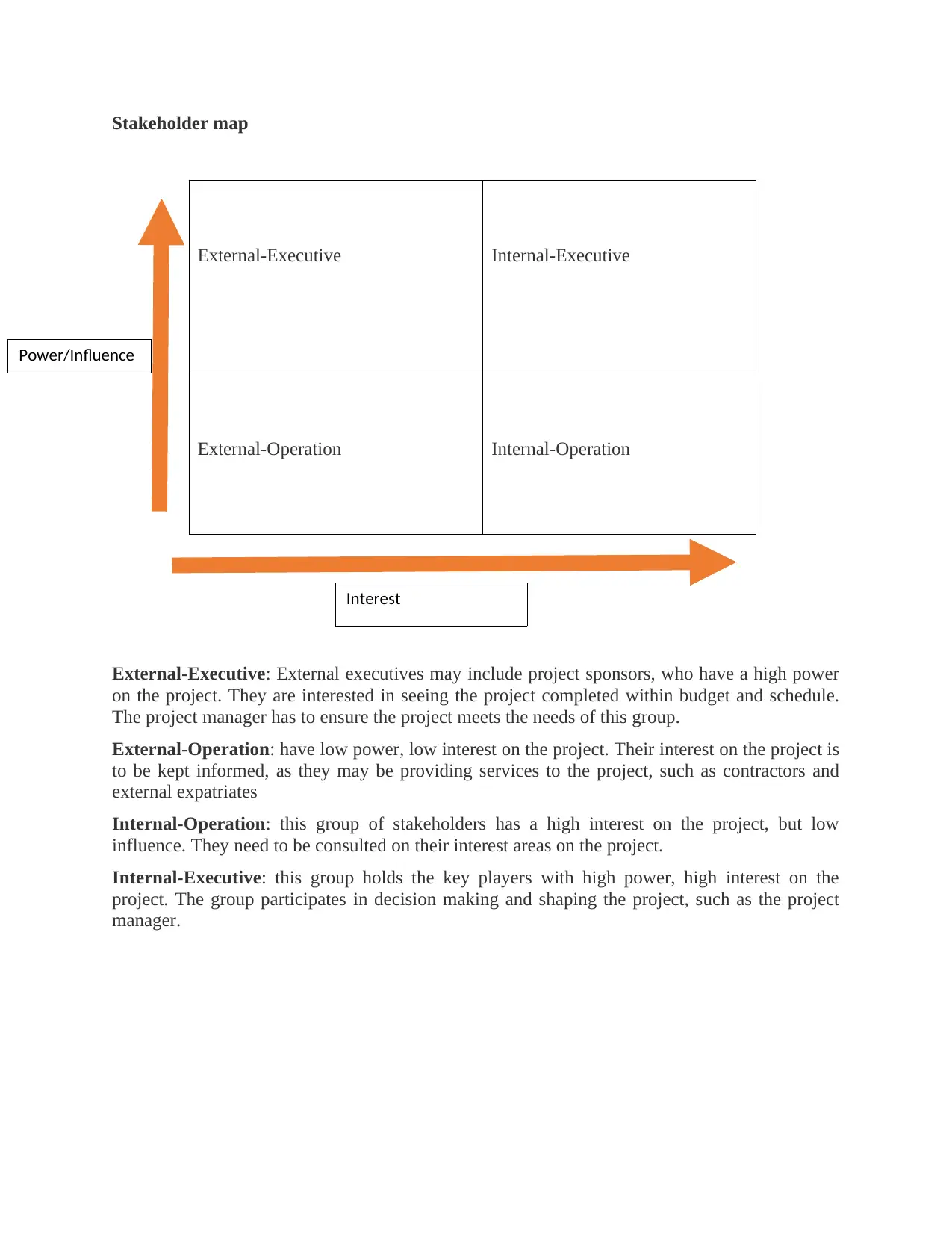
Stakeholder map
External-Executive Internal-Executive
External-Operation Internal-Operation
External-Executive: External executives may include project sponsors, who have a high power
on the project. They are interested in seeing the project completed within budget and schedule.
The project manager has to ensure the project meets the needs of this group.
External-Operation: have low power, low interest on the project. Their interest on the project is
to be kept informed, as they may be providing services to the project, such as contractors and
external expatriates
Internal-Operation: this group of stakeholders has a high interest on the project, but low
influence. They need to be consulted on their interest areas on the project.
Internal-Executive: this group holds the key players with high power, high interest on the
project. The group participates in decision making and shaping the project, such as the project
manager.
Power/Influence
Interest
External-Executive Internal-Executive
External-Operation Internal-Operation
External-Executive: External executives may include project sponsors, who have a high power
on the project. They are interested in seeing the project completed within budget and schedule.
The project manager has to ensure the project meets the needs of this group.
External-Operation: have low power, low interest on the project. Their interest on the project is
to be kept informed, as they may be providing services to the project, such as contractors and
external expatriates
Internal-Operation: this group of stakeholders has a high interest on the project, but low
influence. They need to be consulted on their interest areas on the project.
Internal-Executive: this group holds the key players with high power, high interest on the
project. The group participates in decision making and shaping the project, such as the project
manager.
Power/Influence
Interest
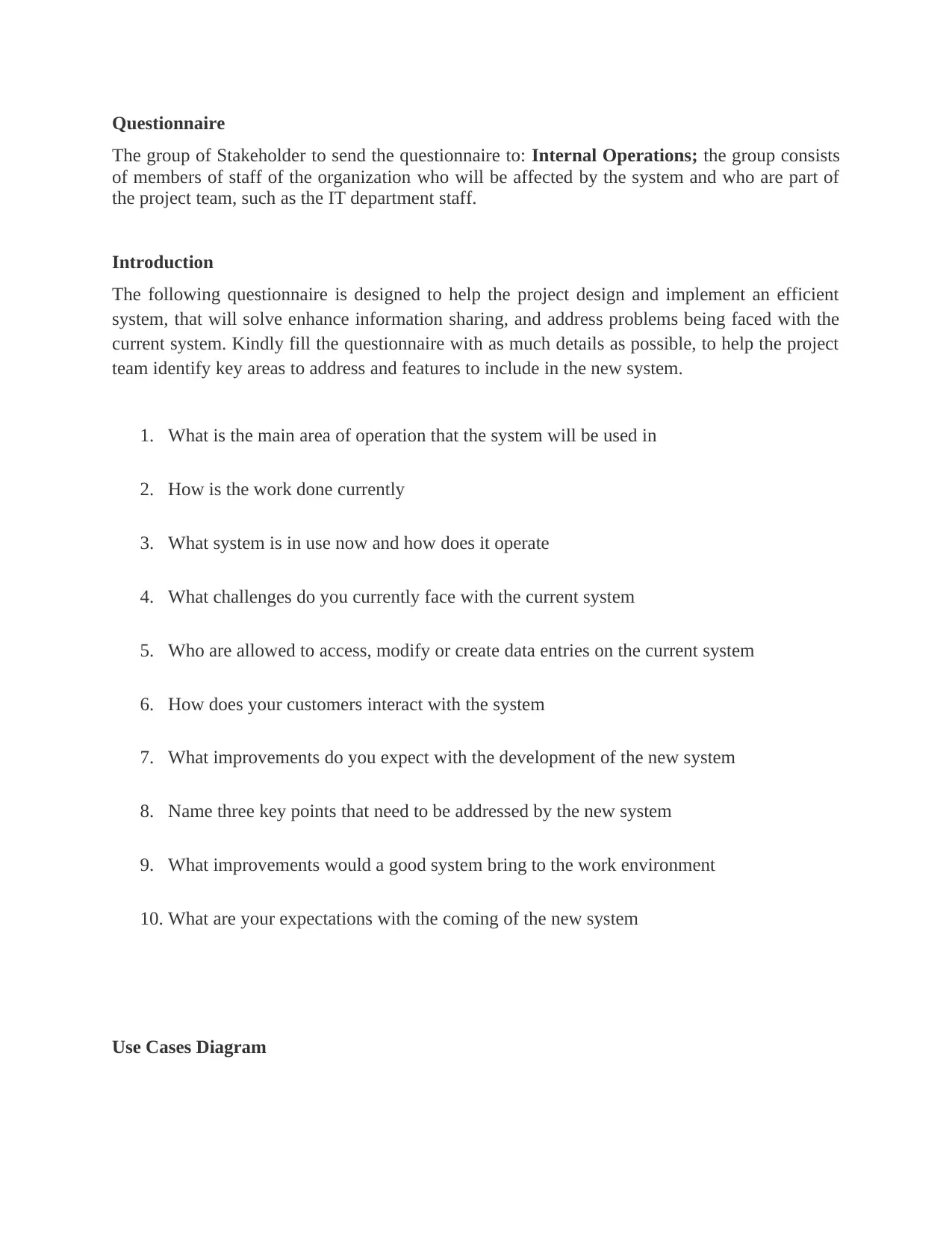
Questionnaire
The group of Stakeholder to send the questionnaire to: Internal Operations; the group consists
of members of staff of the organization who will be affected by the system and who are part of
the project team, such as the IT department staff.
Introduction
The following questionnaire is designed to help the project design and implement an efficient
system, that will solve enhance information sharing, and address problems being faced with the
current system. Kindly fill the questionnaire with as much details as possible, to help the project
team identify key areas to address and features to include in the new system.
1. What is the main area of operation that the system will be used in
2. How is the work done currently
3. What system is in use now and how does it operate
4. What challenges do you currently face with the current system
5. Who are allowed to access, modify or create data entries on the current system
6. How does your customers interact with the system
7. What improvements do you expect with the development of the new system
8. Name three key points that need to be addressed by the new system
9. What improvements would a good system bring to the work environment
10. What are your expectations with the coming of the new system
Use Cases Diagram
The group of Stakeholder to send the questionnaire to: Internal Operations; the group consists
of members of staff of the organization who will be affected by the system and who are part of
the project team, such as the IT department staff.
Introduction
The following questionnaire is designed to help the project design and implement an efficient
system, that will solve enhance information sharing, and address problems being faced with the
current system. Kindly fill the questionnaire with as much details as possible, to help the project
team identify key areas to address and features to include in the new system.
1. What is the main area of operation that the system will be used in
2. How is the work done currently
3. What system is in use now and how does it operate
4. What challenges do you currently face with the current system
5. Who are allowed to access, modify or create data entries on the current system
6. How does your customers interact with the system
7. What improvements do you expect with the development of the new system
8. Name three key points that need to be addressed by the new system
9. What improvements would a good system bring to the work environment
10. What are your expectations with the coming of the new system
Use Cases Diagram
⊘ This is a preview!⊘
Do you want full access?
Subscribe today to unlock all pages.

Trusted by 1+ million students worldwide
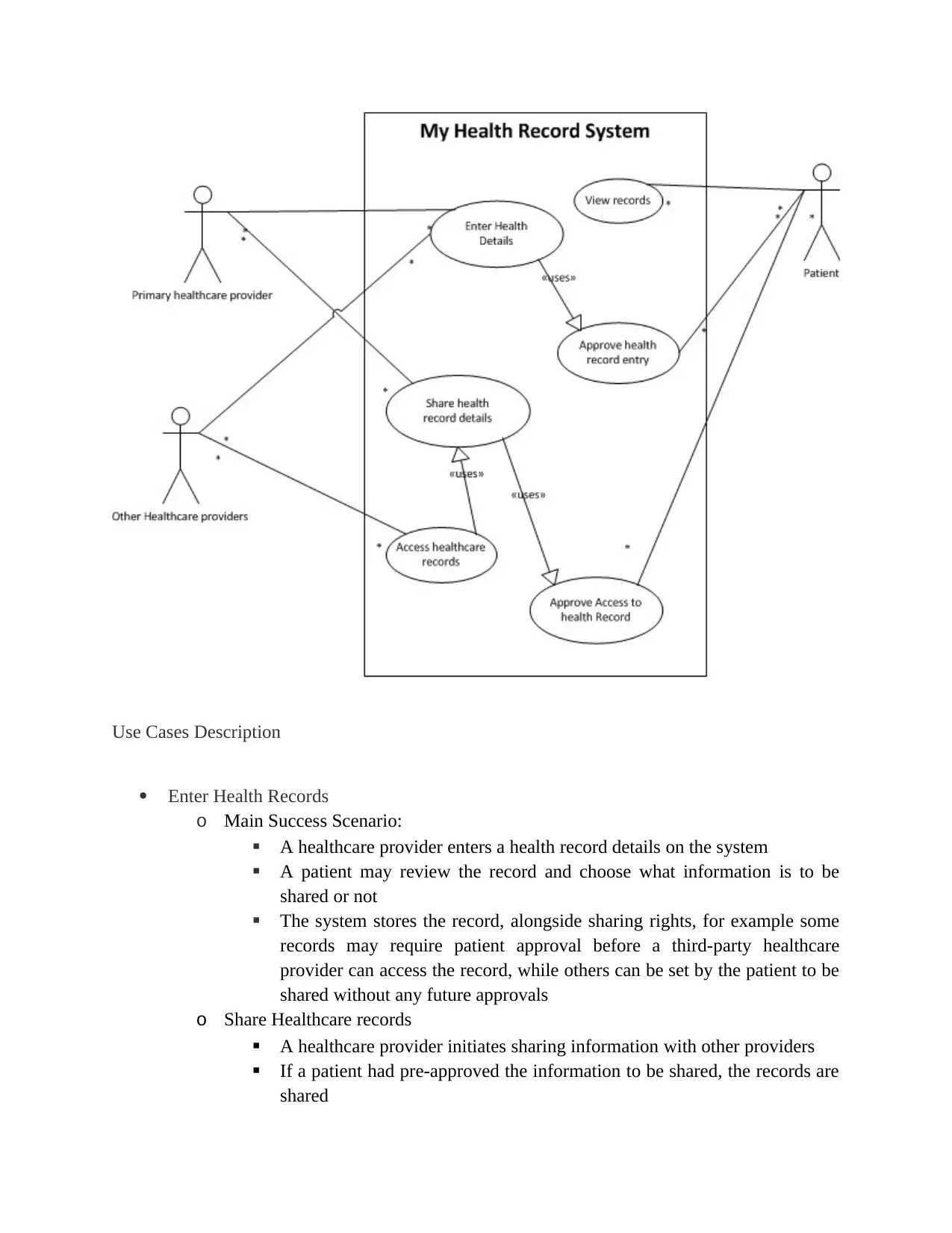
Use Cases Description
Enter Health Records
o Main Success Scenario:
A healthcare provider enters a health record details on the system
A patient may review the record and choose what information is to be
shared or not
The system stores the record, alongside sharing rights, for example some
records may require patient approval before a third-party healthcare
provider can access the record, while others can be set by the patient to be
shared without any future approvals
o Share Healthcare records
A healthcare provider initiates sharing information with other providers
If a patient had pre-approved the information to be shared, the records are
shared
Enter Health Records
o Main Success Scenario:
A healthcare provider enters a health record details on the system
A patient may review the record and choose what information is to be
shared or not
The system stores the record, alongside sharing rights, for example some
records may require patient approval before a third-party healthcare
provider can access the record, while others can be set by the patient to be
shared without any future approvals
o Share Healthcare records
A healthcare provider initiates sharing information with other providers
If a patient had pre-approved the information to be shared, the records are
shared
Paraphrase This Document
Need a fresh take? Get an instant paraphrase of this document with our AI Paraphraser
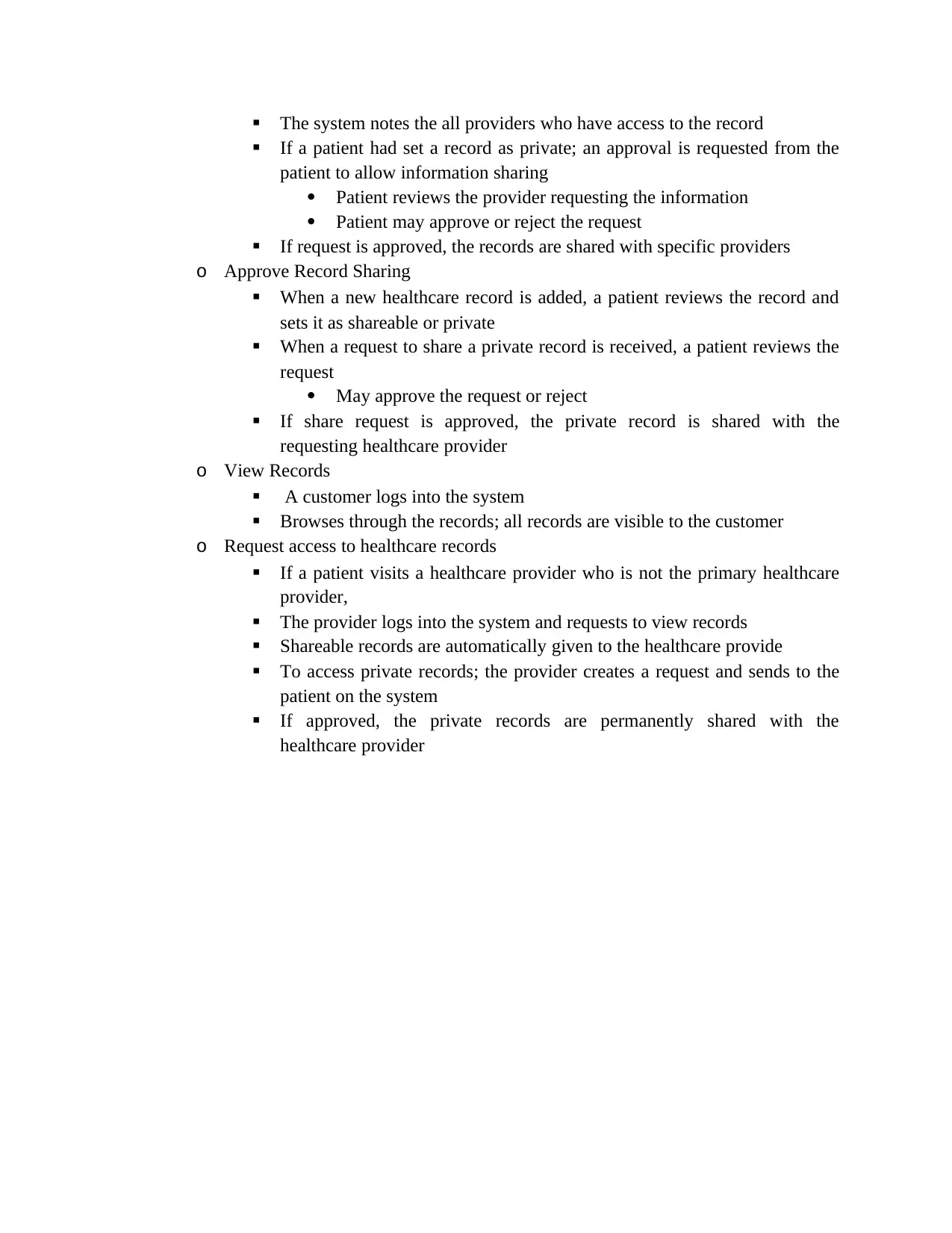
The system notes the all providers who have access to the record
If a patient had set a record as private; an approval is requested from the
patient to allow information sharing
Patient reviews the provider requesting the information
Patient may approve or reject the request
If request is approved, the records are shared with specific providers
o Approve Record Sharing
When a new healthcare record is added, a patient reviews the record and
sets it as shareable or private
When a request to share a private record is received, a patient reviews the
request
May approve the request or reject
If share request is approved, the private record is shared with the
requesting healthcare provider
o View Records
A customer logs into the system
Browses through the records; all records are visible to the customer
o Request access to healthcare records
If a patient visits a healthcare provider who is not the primary healthcare
provider,
The provider logs into the system and requests to view records
Shareable records are automatically given to the healthcare provide
To access private records; the provider creates a request and sends to the
patient on the system
If approved, the private records are permanently shared with the
healthcare provider
If a patient had set a record as private; an approval is requested from the
patient to allow information sharing
Patient reviews the provider requesting the information
Patient may approve or reject the request
If request is approved, the records are shared with specific providers
o Approve Record Sharing
When a new healthcare record is added, a patient reviews the record and
sets it as shareable or private
When a request to share a private record is received, a patient reviews the
request
May approve the request or reject
If share request is approved, the private record is shared with the
requesting healthcare provider
o View Records
A customer logs into the system
Browses through the records; all records are visible to the customer
o Request access to healthcare records
If a patient visits a healthcare provider who is not the primary healthcare
provider,
The provider logs into the system and requests to view records
Shareable records are automatically given to the healthcare provide
To access private records; the provider creates a request and sends to the
patient on the system
If approved, the private records are permanently shared with the
healthcare provider
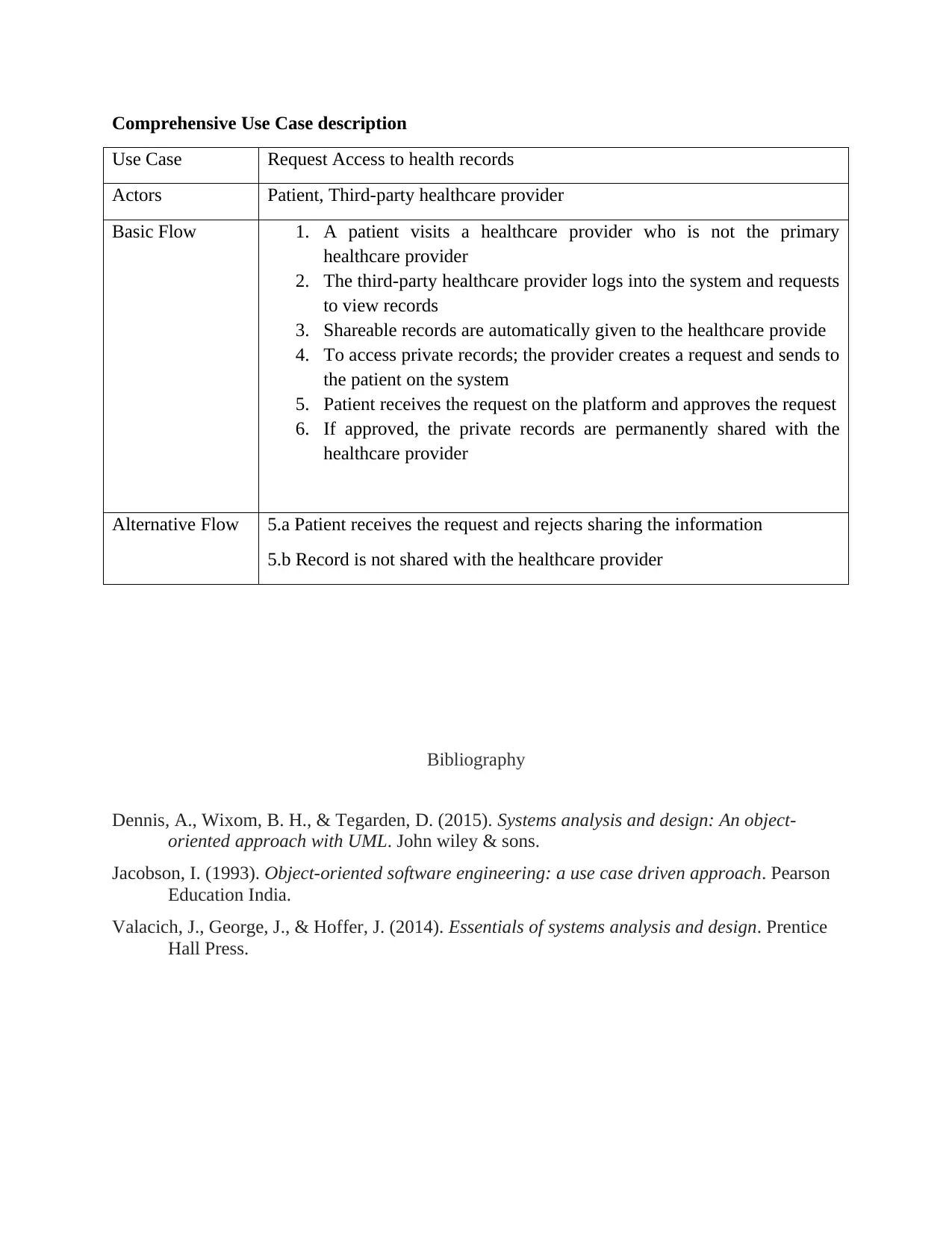
Comprehensive Use Case description
Use Case Request Access to health records
Actors Patient, Third-party healthcare provider
Basic Flow 1. A patient visits a healthcare provider who is not the primary
healthcare provider
2. The third-party healthcare provider logs into the system and requests
to view records
3. Shareable records are automatically given to the healthcare provide
4. To access private records; the provider creates a request and sends to
the patient on the system
5. Patient receives the request on the platform and approves the request
6. If approved, the private records are permanently shared with the
healthcare provider
Alternative Flow 5.a Patient receives the request and rejects sharing the information
5.b Record is not shared with the healthcare provider
Bibliography
Dennis, A., Wixom, B. H., & Tegarden, D. (2015). Systems analysis and design: An object-
oriented approach with UML. John wiley & sons.
Jacobson, I. (1993). Object-oriented software engineering: a use case driven approach. Pearson
Education India.
Valacich, J., George, J., & Hoffer, J. (2014). Essentials of systems analysis and design. Prentice
Hall Press.
Use Case Request Access to health records
Actors Patient, Third-party healthcare provider
Basic Flow 1. A patient visits a healthcare provider who is not the primary
healthcare provider
2. The third-party healthcare provider logs into the system and requests
to view records
3. Shareable records are automatically given to the healthcare provide
4. To access private records; the provider creates a request and sends to
the patient on the system
5. Patient receives the request on the platform and approves the request
6. If approved, the private records are permanently shared with the
healthcare provider
Alternative Flow 5.a Patient receives the request and rejects sharing the information
5.b Record is not shared with the healthcare provider
Bibliography
Dennis, A., Wixom, B. H., & Tegarden, D. (2015). Systems analysis and design: An object-
oriented approach with UML. John wiley & sons.
Jacobson, I. (1993). Object-oriented software engineering: a use case driven approach. Pearson
Education India.
Valacich, J., George, J., & Hoffer, J. (2014). Essentials of systems analysis and design. Prentice
Hall Press.
⊘ This is a preview!⊘
Do you want full access?
Subscribe today to unlock all pages.

Trusted by 1+ million students worldwide
1 out of 6
Related Documents
Your All-in-One AI-Powered Toolkit for Academic Success.
+13062052269
info@desklib.com
Available 24*7 on WhatsApp / Email
![[object Object]](/_next/static/media/star-bottom.7253800d.svg)
Unlock your academic potential
Copyright © 2020–2025 A2Z Services. All Rights Reserved. Developed and managed by ZUCOL.





